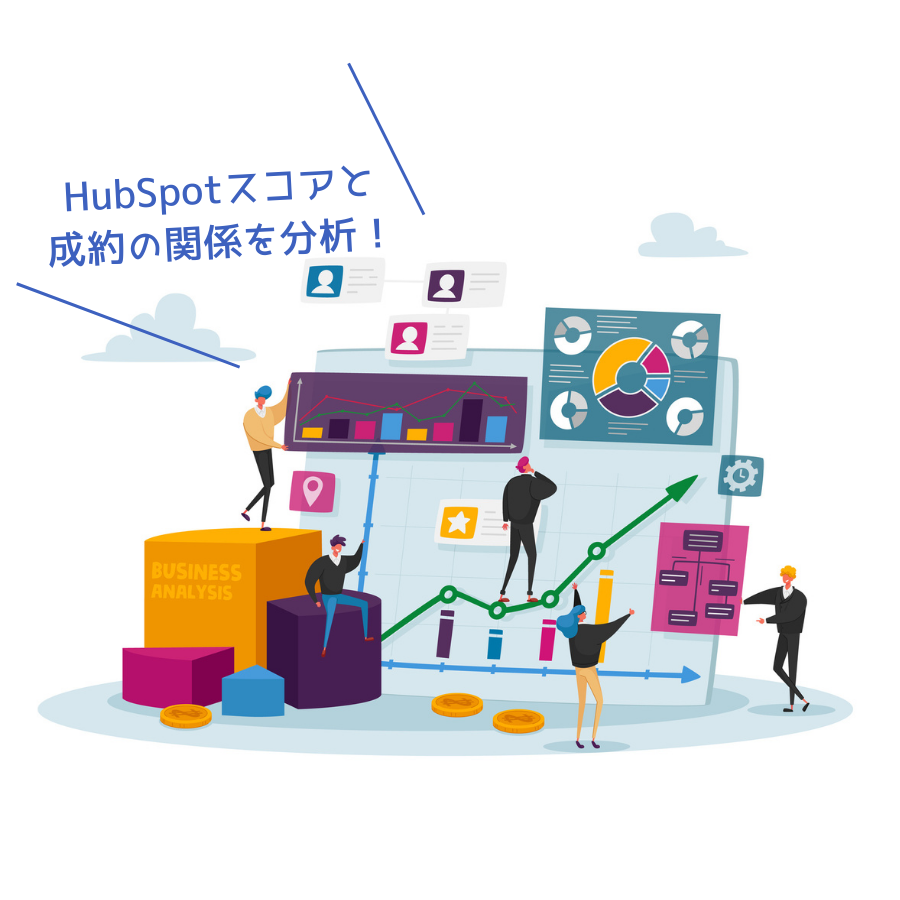Introduction
The first thing we think about when we implement HubSpot or any other sales support tool is its contribution to sales, but unfortunately, using a sales support tool does not necessarily increase sales.
In order for us to make good use of sales support tools, we must analyze the many indicators that can be obtained from sales support tools and find the factors that increase sales.

This article assumes that you have HubSpot installed, and focuses on "closing results" and "HubSpot score" from among a number of indicators, explaining how to analyze the relationship between them, and even how to predict closing rates.
How to find the closing rate
The closing rate is simply the result of a customer's purchase or contract divided by the number of negotiated deals. In other words, if the number of closed deals is 300 out of 1,000 negotiated deals in a year, the close rate is 30%.
The contract closeout result is a property called "Lifecycle Stage," which is built into HubSpot contacts by default, so we will use this property. Also, let's use "1 contract, 1 contact", assuming that one person in charge of the customer who was central to the contract is a prospect.
If you are creating original deal results, you could also set the property "Signed" for contacts that have reached the deal stage from the HubSpot Sales Hub's "Deal Pipeline". In order to generate a close rate, you should be able to see whether or not each contact has been closed.
ABOUT HubSpot SCORE
HHubSpot Score is a calculated property that is a default property in HubSpot, but can be created with original properties.
This calculated property can be scored with any number of points using various data recorded in HubSpot, list memberships, etc.
For example, you can score a customer as +1 point for a form conversion, +2 points for a meeting, etc. There are many ways to think about scoring HubSpot scores, but scoring customer activity that accumulates over time The HubSpot Score is a time series of customer activity that can be compared to a contact's profile and the characteristics of the company they work for. For more information on how to use HubSpot Scores, please visit HubSpot's Knowledge Base.
Is the HubSpot score really valid?
Now, are HubSpot scores really valid, because as you can see from the way HubSpot scores are set up, the indicators can be arbitrarily weighted and the score is calculated on the sum of the weights.
「Is it related to the closing result?」
「Is the weighting of the score correct in the first place?」
I am skeptical about this.
However, if you can quantify customer activity and analyze it "as it relates to closing results," the HubSpot score can be a very meaningful metric.

I liken it to a coin toss...
Since it is difficult to understand the contract signing rate as it is, let us recall the probability of getting two sides of the same coin in the "coin toss," which is considered to be a teppan subject in probability statistics.
.png?width=1600&name=HubSpot%20SCORE_TW%20(1).png)
What are the odds of two sides of a coin?
The "coin toss" is indicated by a specially shaped probability distribution called a "discrete probability distribution," but what we would like to consider further is that the coin is subject to various influences before it falls, and the result may be biased, such as being more likely to turn up Heads or to turn down Flips. Possible factors include the weight and center of gravity of the coin, the height of the toss, the angle, the number of revolutions, the strength of the wind, the solidity and angle of the place where it fell, and the earth's gravity is another influencing factor.
The coin rises and falls under these many influences, and if we can accurately measure and reproduce these influences, we should be able to reproduce any bias in the results of the coin toss.
Relationship between closing results and HubSpot score
Let's go back to the contract signing results.
What if we replace the relationship between closing results and HubSpot Score with the two sides of a coin like a coin and the influencing factors on the coin, and the influencing factors on the coin with HubSpot Score?
There are various indicators of customer activity that can be recorded in HubSpot, such as form conversions, number of web views, meeting results, etc. If we index it as a HubSpot score, wouldn't it be possible to quantify the customer activity and see what the relationship is with the closing result?
Introduction of Logit Model
It is difficult to deal analytically with the relationship between "discrete probability distributions" and "continuous probability distributions," such as the probability of the aforementioned "coin toss," and computers have supported this development. I will not go into details here, but if the result of a coin toss is normally distributed, the least-squares method can be used, but it could not be accurately applied to "discrete probability distributions. However, it was not until 1970 that James Tobin, Daniel McFadden, and others developed methods that could compute "discrete probability distributions" both mathematically and analytically. These models, called Tobit and Logit models, earned them the Nobel Prize in Economics for their work. In particular, logit models are used to analyze choices we face in our daily lives, for example, in transportation planning, such as the choice of bus, train, or airplane transportation, and in marketing research, such as what kind of products consumers choose.
Theory of Logit Model
The concept of the logit model is illustrated in the figure below.
The logit model has only 1 or 0 results, but more points are clustered on the left side of the line of 0s and more points are clustered on the right side of the line of 1s. Can you intuitively imagine what the diagram might look like if you plot the HubSpot score for closed contracts as 1, the HubSpot score for unclosed contracts as 0, and the HubSpot score for closed contracts as 1 on a straight line of 1, and the HubSpot score for unclosed contracts as 0 on a straight line of 0?
Once you have such a diagram in mind, all that remains is to solve the equation for this curve.

Solving the Logit Model
The mathematical solution method is not detailed here, but since the logit model cannot be solved in aggregate like the least squares method, it is computed using the maximum likelihood estimation method. This maximum likelihood estimation method is built into statistical packages such as SPSS and STATA, as well as statistical libraries in R and Python, so even without knowledge of the maximum likelihood estimation method, it can be computed by simply writing a few lines of script.
For example, if the distribution of HubSpot scores for 150 people is as shown in the figure below, the closer the score is from 1 to 10, the more likely it is to close a deal. score of "10" is whether or not a deal is closed, the coefficients are estimated using the maximum likelihood estimation method.
In the logit model, as in other statistical models, it is necessary to check the certainty of the model, not the correlation coefficient as in the least squares method, but the magnitude of the likelihood ratio and the P-value of the coefficient. If these are found to be significant, the next step is to find the theoretical values.


By substituting coefficients into the theoretical equation of the logit model, the sign-up results of the discrete distribution are calculated as a continuous sign-up rate. In this example, the closing rate is calculated for each HubSpot score with a maximum value of 10 points and graphed in the figure below.
As you can see in this figure, the S-curve of the logit model is drawn as described above. Furthermore, the closing rate for each HubSpot score is 90% for a score of 10, and less than 20% for a score of 1. Since there were 150 contacts with prospects registered in HubSpot, we calculated the closing rate for all 150 contacts, and the sum of all 150 contacts was about 60, which means that the number of successful contacts is expected to be about 60.

Conclusion
Effective use of data stored in HubSpot
In this paper, we analyzed only the one-to-one relationship between closing results and HubSpot score, but demographic factors such as activity, company size, etc. also have an impact on closing results. The logit model introduced in this paper can also be used for one-to-many variable analysis, allowing for a wide range of analysis. However, there are many points to keep in mind when applying the model, such as independence and multicollinearity among variables, so please ask for an expert's opinion or contact our company, which specializes in analysis.
Use of classical statistical models and their development into AI (machine learning)
Models such as the logit model used in this study, which assumes a probability distribution and uses a selection of variables, are classical statistical models, but nowadays it is also possible to use machine learning, which is a basic AI technology. The advantage of opportunity learning is that, above all, it does not require much thinking, and if you create a model using all the data you have at hand, you can obtain reasonably correct results. On the other hand, the classical model has the advantage that the effects of variables are easy to understand, so the target segment is clear, and it is easy to reflect the results in marketing and business strategies. There is no one-size-fits-all approach to which is better than the other, so it is necessary to determine the purpose and use the model or analysis method rather than simply choosing one over the other.
Translated with DeepL
The relationship between customer and seller.
Finally, when I look back at myself, I see myself as a customer of some company and myself as a seller who wants customers to use my services. As a customer, I do not like to be sold to, but I want new information, and as a seller, I want my services to be used, and both of these always coexist.
If this kind of analysis method is used appropriately, customers will be happy if they are introduced to products at the right time, and if products are introduced at the right time, there will be no need for unnecessary sales pitches. I hope that society will become such a society.



.png?width=1600&name=HubSpot%20SCORE_TW%20(1).png)

